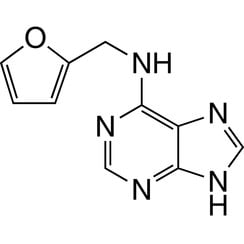You have no items in your shopping cart
Kinetin
Kinetin is a type of cytokinin, a class of plant hormone that promotes cell division. Kinetin was originally isolated by Miller and Skoog et al. as a compound from autoclaved herring sperm DNA that had cell division-promoting activity. It was given the name kinetin because of its ability to induce cell division, provided that auxin was present in the medium. Kinetin is often used in plant tissue culture for inducing formation of callus (in conjunction with auxin) and to regenerate shoot tissues from callus (with lower auxin concentration).
For a long time, it was believed that kinetin was an artifact produced from the deoxyadenosine residues in DNA, which degrade on standing for long periods or when heated during the isolation procedure. Therefore, it was thought that kinetin does not occur naturally, but, since 1996, it has been shown by several researchers that kinetin exists naturally in the DNA of cells of almost all organisms tested so far, including human and various plants. The mechanism of production of kinetin in DNA is thought to be via the production of furfural — an oxidative damage product of deoxyribose sugar in DNA — and its quenching by the adenine base's converting it into N6-furfuryladenine, kinetin.
Kinetin is also widely used in producing new plants from tissue cultures.

